Knowledge | Effort | Develop | Success
Hitting Secrets: The 4-Step Guide to Developing an Elite Level Baseball or Softball Swing
Introduction
Having spent over 15 years working with hitters and seriously thinking about how to best go about developing a really good swing, I believe there are 4 key things that need to be understood to effectively teach or develop a high level swing. Anyone who has spent any amount of time trying to understand how elite level hitters swing the bat as well as they do, should realize that swinging a bat well is not an easy thing to learn. The fact is that if it was easy we would see many more hitters than we do swinging the bat really well by the time they get to high school. From my vantage point I do NOT see many hitters at the high school level or lower levels that really know how to swing a bat in a manner that really makes me take notice There are some relatively simple ideas that can be applied to really help either a coach, dad or player develop a much better capacity to understand what a good swing actually is. One of the key aspects of becoming a really effective hitting instructor is the ability to understand how a swing actually happens, while simultaneously being able to convey this in ways that the average player, parent, or coach can readily understand.
1) Aligning The Bat And Body From Initiation Of The Swing Into Contact
Good bat/body alignment has to do with the body posture and the bat at the point at which the hitter is starting (initiating) the actual swing. Elite level hitters have a certain “look”, so to speak, as they initiate the swing. That look is a function of how they load the body. I will go into this loading shortly; for now I just want to focus on the look of an elite level hitter, relative to most non-elite or lower level hitters.
Take a look at how elite level hitters look at the start of the swing:

Compare that to how non-elite hitters look at the start of the swing:

In looking at elite level hitters and how they have aligned bat and body when they start to swing, the following components are almost always seen:
1) The head to spine alignment is generally “centered”, relative to the base of support (the legs and feet).

2) The lead arm is “sufficiently up” and somewhat stretched such that the lead elbow is behind the sternum (middle of chest).

3) The hips are flexed, the spine is tilted such that the shoulders are closer to the plate, relative to the hips.

Contrast these postural/loading parameters with lower level hitters:
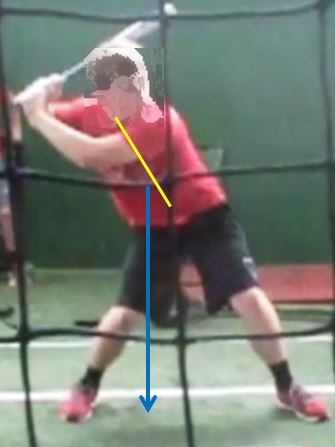

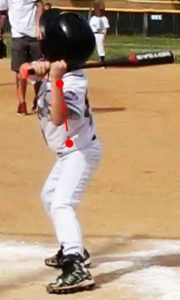
For a complete understanding of the Initiation Geometries of the elite baseball swing, click here.
The essential point to understand about the fact that elite level hitters all look very similar as they start the swing is simply this:
In order to even have a chance at consistently hitting a ball really well, a baseball or softball player has to create a certain type of bat and body alignment that will provide for
1) Sufficient bat speed;
2) Swing quickness;
3) Barrel accuracy, i.e., the ability to “square up” pitches and hit line drive trajectories on a relatively consistent basis (“relative” meaning compared to non-elite level hitters).
The primary reason “The Look” exists is based on the relatively severe time constraint that hitters are working within at all levels, but most acutely at the MLB level. As a recent ESPN Sports Science episode pointed out that the entire swing process happens “within a blink of an eye.” This means that from the time the pitcher releases the ball to the time the ball crosses the plate, the time frame of this happens elapsed occurs Within A Blink Of An Eye!!!
If a player starts the swing with poor bat and body alignment they will have zero chance of being able to consistently hit balls well. Period. This is not my theory. This is not a rule that I invented. Elite hitters have “The Look” because there is simply not enough time to start the swing from the variety of postures non-elite hitters find themselves in. So, if you want to have a chance of developing a high level swing you simply must learn to create the kind of bat and body alignment that elite level hitters have learned how to create!! It boils down to the importance of being able to create a very good “geometry” of the bat and body as you start the swing.
The second part of good bat and body alignment has to do with being able to maintain sufficient stability of certain body parts from the start of the swing to contact.
Any athlete that is creating high level movements is always combining in a very coordinated manner both mobility and stability of the body segments and joint actions. Swinging a bat at a high level is no different. Swinging a bat at a high level requires a good deal of mobility of the muscles of the trunk creating rotation around the axis of the spine. The back leg is also mobile in that the leg and heel need to flex (heel lifts/knee bends) in order to facilitate better rotation.
What needs to be stable?
The spine needs to remain relatively stable; one should not create much if any flexion or extension of the spine from the initiation of the swing until contact. And the arms, specifically the elbow joints, should not flex or extend much if any from the initiation of the swing until what is referred to as the “Lag” position.

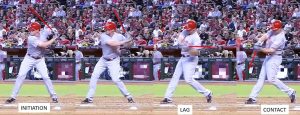


And even beyond lag, or from lag to contact elite level hitters are not actively extending the elbow joints much if any on their typical good swing.
The lack of pushing /extending can be understood by looking at the lag to contact stills:
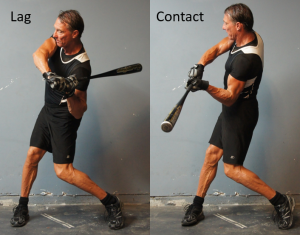
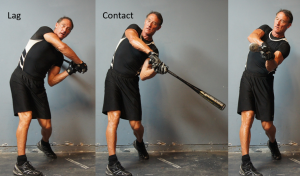
What really should be understood is that there is a significant difference in how elite level hitters create extension, compared to how lower level hitters extend the arms. The extension shown by some hitters on certain swings is caused by the centrifugal force of the barrel accelerating around the “pivot point” of the hands. This large force creates what I refer to as a “pulling effect” on the arms and wrists. On the other hand, the typical kind of arm extension displayed by lower level hitters is caused by the natural “reaching” tendencies.
There are 2 other components that require a good deal of stability once the swing actually starts:
1) The lead leg should to be relatively stable from initiation to contact. The lead leg should not bend (flex) or straighten (extend) in the first few frames of a swing (frames being a reference to looking at a swing in slow motion). The lead leg is acting as a kind of “anchor” or foundation which the trunk and arms are rotating around and against. A lack of stability of the lead leg can degrade the speed and quickness of the trunk rotation and/or can facilitate a breakdown of the swing plane and barrel accuracy.
2) The center of mass, i.e. the pelvic region of the body, should not be moving forward much if any from initiation to contact. Meaning that the trunk (hips to shoulders) should be rotating around a stable spine from the actual start of the swing until contact.
Bottom line: In order to develop an elite level swing a baseball or softball player has to combine stability and mobility of the body and bat in order to create the kind of bat speed, swing quickness, and barrel accuracy that is typical of a high level swing.
2) Elite Level Hitters Know How To Rotate The Trunk
In conjunction with good bat and body alignment at initiation and good stability of that alignment into lag and into contact, elite level hitters know how to optimally energize and direct this good alignment by creating very good trunk rotation.
A key aspect of this trunk rotation is the ability to accelerate the hip rotation as the hitter goes INTO foot plant and then an instant later, the entire trunk starts to rotate around the spine.
This very subtle sequencing of the trunk rotation (hips to shoulders) aids in an optimal link of the arms/bat to the muscle actions of the trunk in rotation where the arms/bat slightly lag behind the hip rotation, but then an instant later, the arms/bat are linked to the combined hip and shoulder rotation.
Or said another way: Elite level hitters know how to both lag the arms/bat and connect the arms/bat to the trunk rotation, due to the combination of good alignment and good rotation from initiation to contact. This kind of good posture (bat/body alignment) and good rotation produces the ability to create and transfer force/momentum from the body to the bat head in a very effective manner. Good alignment and good turning (trunk rotation) causes a lot of good things to happen when swinging a bat!
In contrast, most non-elite hitters neither align body parts well, nor do they rotate well and this leads to numerous breakdowns of the swing, e.g., a loss of swing quickness, a loss of bat speed, many more mis-hit balls.
To repeat, elite level hitters know how to rotate the hips ….INTO foot plant. This is a critical aspect of how elite level hitters swing, and as such it bears repeating.
I would also argue that few people understand that elite level hitters can and will slightly modify this kind of hip to shoulder sequencing when “anticipating” slower pitches. However, this type of subtle adjustment is exactly that, a slight deviation from their typical ability to start the hip rotation as they go into foot plant. An ability that escapes non-elite hitters.
When you combine this good bat and body alignment with very good hip rotation, it starts this process of connecting the arms and bat to this rotational momentum of the hips accelerating as the hitter goes into foot plant. From foot plant the mid and upper trunk starts to accelerate into rotation as well.
The shoulder rotation very quickly links to the hip rotation, such that from foot plant until contact the entire trunk (hips to shoulders ) are acting in concert to optimize the “pulling effects” of the trunk on the arms and bat. The angular momentum developed by the trunk rotation is pulling the arms and bat around the body and into contact.
Here is a very good clip to show an elite level hitter rotating the hips INTO foot plant:

Rotating the hips into foot plant and then very quickly rotating the mid to upper trunk an instant later:

And here’s one more clip that shows very well the hip to shoulder rotation and how the arms and bat are being pulled around the body as this occurs:

These are very good examples of the speed and sequencing of the hip and trunk rotation.
To repeat, THIS kind of hip rotation into foot plant very quickly followed by the entire trunk rotating is typical of elite level hitters. At lower levels most players tend to “lead” with the arms starting the actual swing as the hips “slide” or are simply too slow in rotating.
So if you want to learn how to develop a really good swing, you have to learn how to rotate the trunk with the kind of speed and well-coordinated muscle sequencing that underlies the kind of rotation that drives an elite level swing.
Good “geometry” (bat/body alignment) and good trunk rotation that results in people looking at elite level hitters and saying things like: “Man this guy looks powerful, effortless, quick, smooth, coordinated, he makes it look so easy”.
Good alignment and good turning. This sounds pretty simple. It would seem easy to accomplish you might be thinking. And I agree that it does sound easy! Yet, as I said above, I see few hitters at the high school level (or below this level) who really know how to create these 2 key aspects of a really good swing. Why is this the case?
Well, the next 2 keys to development that I am going to talk about will help to explain this.
3) Overcoming The “Natural Tendency” To Use The Arms To Swing The Bat
Remember, really good hitters swing the bat well because they know how to align the body and bat effectively as they start the swing and they maintain this good bat and body alignment into contact and they know how to rotate the trunk in a very rapid and coordinated manner. Elite hitters have learned a different kind of motor strategy to apply to swinging a bat. What do I mean by “different”?
There is a very natural tendency to organize the swing around the arms moving to try to hit a ball. This kind of strategy is very different from how elite level hitters actually utilize the entire body to swing. In other words, most young and/or non-elite level hitters primarily use the arms when they swing a bat.
One main reason for this tendency is based in large part on the fact that this motor strategy comes from our past experience reaching out for objects from a very early age. By the time someone reaches the age of 6 or 7 they have developed a good deal of experience manipulating their arms and hands to find and grab objects out in front of their body. This is certainly readily apparent when watching young hitters at the tee ball level. Watch any tee baller rehearse their swing; what they are showing amounts to moving the arms from their initial set-up position to contact. They are doing this with no thought about the rest of the body and how it should be aligned and loaded. In effect, the bat is simply an extension of their arms. It makes sense for a youngster to apply his or her reaching experience when they first learn to swing a bat.
Now, what some of you may be thinking right about now is “Well ok Steve I see what you are saying about young hitters just trying to mostly use the arms to get the bat around. But don’t most hitters learn to get beyond this? Don’t most hitters really learn how to use their whole body to hit as they get older?” This is a reasonable argument to make. But it is as inaccurate as it is reasonable. In fact, I would argue that most hitters never fully overcome this kind of natural tendency to use the arms when swinging a bat. Sure, most all get bigger and stronger as they get older. But, becoming bigger and stronger does not really translate into developing an ability to effectively utilize the trunk to generate most of the force and momentum to move the bat.
Watching hitters at the high school level, the most common thought I have about these hitters is that they have a pretty decent body and seem to move on the field pretty well, but doesn’t really have a clue as to how to use his body to swing the bat. The few I do see that have a pretty good sense of how to use their body to swing, they are almost always guys who are going to college on scholarship or are going to be drafted. Somehow these guys figured out how to get beyond the typical arm swinging pattern.
This is why I say that this tendency to try to use the arms to swing a bat is natural. It is the norm. Conversely, good hitters have learned to do the “unnatural thing”. They have learned to minimize arm movement and optimize the trunk movement (rotation around the spine). They have learned how to align the bat and body well and have learned how to rotate the trunk really well.
One more point about this natural tendency and inability to overcome it. The sad fact is that this inability to get beyond this normative arm swinging pattern is many times a function of poor hitting instruction. Unfortunately most hitting instructors do not have what I consider to be a sufficient understanding of how a good swing actually happens. If you want to develop a really good swing, it would be very helpful to work with instructors that have a good working understanding of how the body works in the context of swinging a bat. How the body works is shorthand for saying that I think an instructor should have a basic knowledge of biomechanics and physiology in order to have a useful understanding as to what is causing movement flaws along with good ideas as to how to correct those flaws. Many of those who develop a really good swing are doing so despite not because of the kind of instruction they are getting. They have learned how to develop movement that goes beyond the typical arm swinging tendencies that most never really overcome.
4) The Intent To Improve
A player must have the intent to change their faulty movement patterns.
I have spent considerable time explaining the kind of mindset that underlies almost all elite level performers. I have tried to convey, citing books about successful people like “Talent is Overrated”, “The Talent Code, “Bounce” and “Mindset”, that a player should always try to find ways to go about improving themselves when practicing. Many times this can amount to simply going about practicing in a more thoughtful and focused manner.
This is one of the underlying purposes of many of my hitting drills. They are designed to force you to be more thoughtful and aware of specific aspects and certain “functional details” of your body posture and body movement. In forcing yourself to become more focused and aware of specific aspects of your body movement, you will better learn how to become more aware and more focused on important details of your movements as you go about this learning process.
The capability to actually create a more thoughtful and focused mindset when practicing derives from an apriori mindset along the lines of “I can think about using my practice time to improve my capabilities” (mental and/or physical). In thinking about practice as the time to do this, you will find that there are many aspects of your performance that could become the focus of your attention when practicing. For example you could take 10 dry swings, where the focus is on keeping the lead leg sufficiently closed. Then, when you go into the cage, the focus becomes that of making sure you do not swing at non-strikes in the live setting. Then, when you go to take, for example, ground balls at third base during batting practice, you get someone to hit balls to your left, so you can focus on staying down and crossing over quickly.
This kind of thoughtful and very purposeful kind of focus can and should be applied through the entire practice, with regards to specific details and aspects of you performance capability. In thinking about practice in this manner you will better learn how to focus on small details and better learn to pay attention to your body movements, and/or some type of specific kind of mental or physical goal that you need to improve upon.
This kind of mindset, a kind of “growth mindset” that sees practice as one continuous opportunity to go about improving in some manner, is the very kind of mindset that elite performers have developed over time which, in large part, explains why they are elite performers.
When researcher Anders Ericsson asked a world class cellist why she was so good, she replied “Well, I guess it’s because I was never quite satisfied with my performance. And so I was always tinkering with ways to improve it.” And she went on to say “I would do a recital in the afternoon. Then I would go home that night and listen to it. I would then pick out the parts I thought were the weakest, and then I would go about trying to improve upon those parts.”
Think about the implications of this kind of mindset. Think about this kind of mindset being applied over minutes, hours, days, weeks, months, years. Is there any wonder as to why and how this cellist developed into a world class performer? Can we simply attribute this kind of development to her having “talent”? I offer a resounding no to both questions.
In many ways the key aspect of the intent to improve is centered around the willingness to work directly on one’s weaknesses. A player typically does not directly learn how to swing a bat well. What actually happens is that as you go about minimizing and ultimately eliminating your flaws, the good swing emerges.
Most people do not want to address their weaknesses. For most I think that there is a strong perception that really working on their weaknesses is going to be a painful and difficult experience. However, for those with a true intent to change and improve, this kind of perception is countered by the understanding that they need to go through this process of doing whatever they need to do to deal with and ultimately modify and eliminate the kinds of flaws that they know are limiting their true potential.
And this kind of intent to change and willingness to directly tackle flaws inherently leads to the kinds of focused practice that is a necessary part of the development of superior performance.
Researcher Anders Ericsson, mentioned above, in an interview offered the following:
The sorts of activities that most people consider “practice” are generally not very helpful in improving one’s performance. A golfer gets in at least eighteen holes every week and tries to hit a bucket of balls at the driving range beforehand. A pianist plays the same exercises over and over until they are completely automatic. A teacher has been teaching the same material in the same way for twenty years, thinking that practice must eventually make perfect. None of these people are likely to see much improvement despite all that “practice.”
To be truly effective, practice must follow a set of principles that we understand quite well now. First, the training must be done at the edge of one’s comfort zone. If it’s easy or it’s automatic, you’re not going to be improving much. Second, effective practice needs to be purposeful. You are doing what you are doing with the specific goal of improving one particular aspect of your performance. Finally, effective practice requires feedback–you need to know what you’re doing wrong so you can figure out ways to correct it. The resulting progress comes as a series of baby steps, none very impressive on its own, but they can add up to an incredible journey.
My experience working with hitters is that those who fail to really improve are almost always those who simply do not really want to improve. In other words, they do not have the intent to improve. Sometimes this is due to really not wanting to spend the kind of time and focus that is really required to substantially improve. Many times it is due to the belief often times reinforced by the parents and coaches that they are already really good and see no need to improve. Regardless of the underlying motivation, my experience is that these hitters never really improve.
From my perspective as an experienced teacher who has seen and worked with many hitters, the bottom line is those who either have or develop an intent to change and improve will succeed over time; they WILL develop their true potential.
I hope you’ve enjoyed this guide as much as I’ve enjoyed creating it for you. I think that if you use this information it will definitely help you to swing the bat better.

